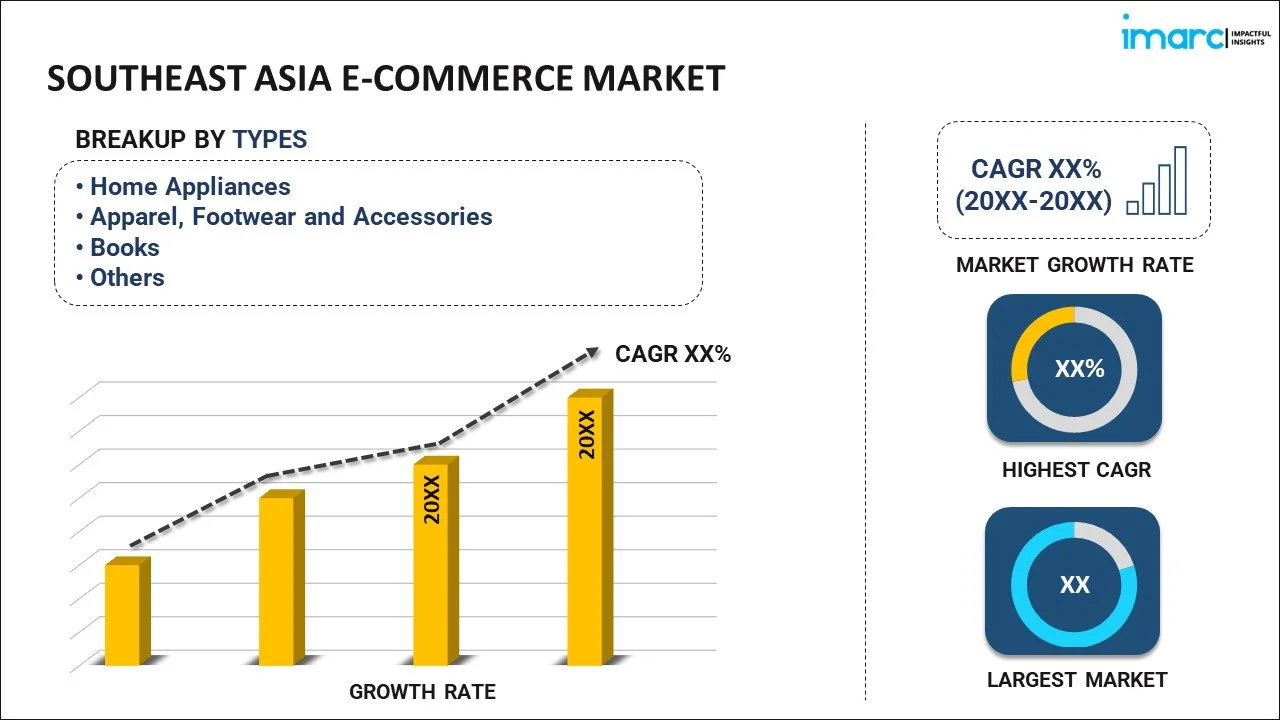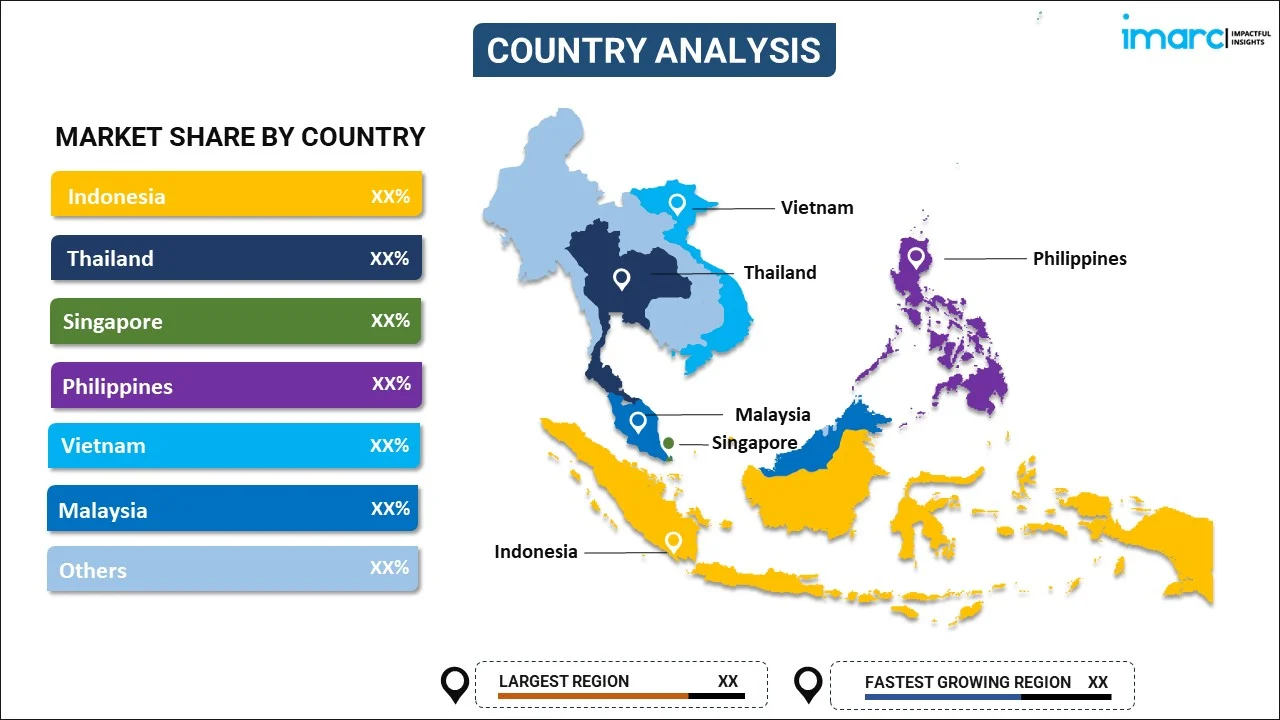
Southeast Asia E-Commerce Market Report by Type (Home Appliances, Apparel, Footwear and Accessories, Books, Cosmetics, Groceries, and Others), Transaction (Business-to-Consumer, Business-to-Business, Consumer-to-Consumer, and Others), and Country 2025-2033
Market Overview:
Southeast Asia e-commerce market size reached USD 221.6 Billion in 2024. Looking forward, IMARC Group expects the market to reach USD 1,480.7 Billion by 2033, exhibiting a growth rate (CAGR) of 21.7% during 2025-2033. The growing cross-border trade opportunities and the widespread adoption of secure digital payment systems represent some of the key factors driving the market.
|
Report Attribute
|
Key Statistics
|
|---|---|
|
Base Year
|
2024
|
|
Forecast Years
|
2025-2033
|
|
Historical Years
|
2019-2024
|
|
Market Size in 2024
|
USD 221.6 Billion |
|
Market Forecast in 2033
|
USD 1,480.7 Billion |
| Market Growth Rate 2025-2033 | 21.7% |
E-commerce, also known as electronic commerce, represents the process of buying and selling an array of goods and services over the internet, serving as a fundamental component of contemporary business practices, revolutionizing the dynamics of product marketing, purchasing, and delivery. This encompasses a diverse range of activities, including the operation of online retail stores, digital marketplaces, and business-to-business transactions. Customers have the convenience of browsing through products, making purchases, and conducting transactions from the comfort of their homes or while on the move, utilizing smartphones and computers. Moreover, it offers several benefits, including ease of use, an extensive product range, and the opportunity to compare prices and peruse reviews before making a purchase.
Southeast Asia E-Commerce Market Trends:
The Southeast Asia e-commerce market is primarily bolstered by the upward trajectory of internet penetration within the region. Furthermore, the widespread adoption of smartphones and internet connectivity has made online shopping a convenient and viable option for consumers, significantly influencing the growth of the market. The proliferation of mobile applications and user-friendly websites has further enhanced the shopping experience, rendering it seamless and easily accessible for customers to explore, compare prices, and make purchases, consequently serving as another key driver of market expansion. Moreover, the outbreak of the coronavirus disease (COVID-19) has expedited the transition to online shopping, intensifying the demand for online retail services. The enforcement of lockdowns and social distancing measures has compelled many consumers to rely heavily on e-commerce platforms for their shopping needs, thereby catapulting the growth of the market within the region. Additionally, e-commerce platforms enable businesses to access international markets without the necessity of physical storefronts, presenting an appealing opportunity for expanding their customer base. This, in turn, is expected to contribute to a favorable market outlook for the Southeast Asia e-commerce market over the forecasted period.
Southeast Asia E-Commerce Market Segmentation:
IMARC Group provides an analysis of the key trends in each segment of the market, along with forecasts at the regional and country levels for 2025-2033. Our report has categorized the market based on type and transaction.
Type Insights:

- Home Appliances
- Apparel, Footwear and Accessories
- Books
- Cosmetics
- Groceries
- Others
The report has provided a detailed breakup and analysis of the market based on the type. This includes home appliances, apparel, footwear and accessories, books, cosmetics, groceries, and others.
Transaction Insights:
- Business-to-Consumer
- Business-to-Business
- Consumer-to-Consumer
- Others
A detailed breakup and analysis of the market based on the transaction have also been provided in the report. This includes business-to-consumer, business-to-business, consumer-to-consumer, and others.
Country Insights:

- Indonesia
- Thailand
- Singapore
- Philippines
- Vietnam
- Malaysia
- Others
The report has also provided a comprehensive analysis of all the major regional markets, which include Indonesia, Thailand, Singapore, Philippines, Vietnam, Malaysia, and Others.
Competitive Landscape:
The market research report has also provided a comprehensive analysis of the competitive landscape in the market. Competitive analysis such as market structure, key player positioning, top winning strategies, competitive dashboard, and company evaluation quadrant has been covered in the report. Also, detailed profiles of all major companies have been provided.
Southeast Asia E-Commerce Market Report Coverage:
| Report Features | Details |
|---|---|
| Base Year of the Analysis | 2024 |
| Historical Period | 2019-2024 |
| Forecast Period | 2025-2033 |
| Units | Billion USD |
| Scope of the Report | Exploration of Historical Trends and Market Outlook, Industry Catalysts and Challenges, Segment-Wise Historical and Future Market Assessment:
|
| Types Covered | Home Appliances, Apparel, Footwear and Accessories, Books, Cosmetics, Groceries, Others |
| Transactions Covered | Business-to-Consumer, Business-to-Business, Consumer-to-Consumer, Others |
| Countries Covered | Indonesia, Thailand, Singapore, Philippines, Vietnam, Malaysia, Others |
| Customization Scope | 10% Free Customization |
| Post-Sale Analyst Support | 10-12 Weeks |
| Delivery Format | PDF and Excel through Email (We can also provide the editable version of the report in PPT/Word format on special request) |
Key Questions Answered in This Report:
- How has the Southeast Asia e-commerce market performed so far and how will it perform in the coming years?
- What has been the impact of COVID-19 on the Southeast Asia e-commerce market?
- What is the breakup of the Southeast Asia e-commerce market on the basis of type?
- What is the breakup of the Southeast Asia e-commerce market on the basis of transaction?
- What are the various stages in the value chain of the Southeast Asia e-commerce market?
- What are the key driving factors and challenges in the Southeast Asia e-commerce?
- What is the structure of the Southeast Asia e-commerce market and who are the key players?
- What is the degree of competition in the Southeast Asia e-commerce market?
Key Benefits for Stakeholders:
- IMARC’s industry report offers a comprehensive quantitative analysis of various market segments, historical and current market trends, market forecasts, and dynamics of the Southeast Asia e-commerce market from 2019-2033.
- The research report provides the latest information on the market drivers, challenges, and opportunities in the Southeast Asia e-commerce market.
- Porter's five forces analysis assist stakeholders in assessing the impact of new entrants, competitive rivalry, supplier power, buyer power, and the threat of substitution. It helps stakeholders to analyze the level of competition within the Southeast Asia e-commerce industry and its attractiveness.
- Competitive landscape allows stakeholders to understand their competitive environment and provides an insight into the current positions of key players in the market.
Need more help?
- Speak to our experienced analysts for insights on the current market scenarios.
- Include additional segments and countries to customize the report as per your requirement.
- Gain an unparalleled competitive advantage in your domain by understanding how to utilize the report and positively impacting your operations and revenue.
- For further assistance, please connect with our analysts.
 Inquire Before Buying
Inquire Before Buying
 Speak to an Analyst
Speak to an Analyst
 Request Brochure
Request Brochure
 Request Customization
Request Customization




.webp)




.webp)












